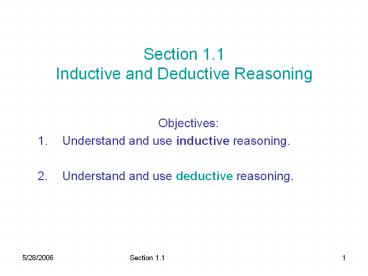Section 1.1 Inductive and Deductive Reasoning - PowerPoint PPT Presentation
Title:
Section 1.1 Inductive and Deductive Reasoning
Description:
Section 1.1 Inductive and Deductive Reasoning Objectives: Understand and use inductive reasoning. Understand and use deductive reasoning. Inductive Reasoning The ... – PowerPoint PPT presentation
Number of Views:270
Avg rating:3.0/5.0
Title: Section 1.1 Inductive and Deductive Reasoning
1
Section 1.1Inductive and Deductive Reasoning
- Objectives
- Understand and use inductive reasoning.
- Understand and use deductive reasoning.
2
Inductive Reasoning
- The process of arriving at a general conclusion
based on observations of specific examples. - Definitions
- Conjecture/hypothesis The conclusion formed as
a result of inductive reasoning which may or may
not be true. - Counterexample A case for which the conjecture
is not true which proves the conjecture is false.
3
Strong Inductive Argument
- In a random sample of 1172 U.S. children ages 6
through 14, 17 said being bossed around is a bad
thing about being a kid. We can conclude that
there is a 95 probability that between 14.1 and
19.9 of all U.S. children ages 6 through 14 feel
that getting bossed around is a bad thing about
being a kid. - This technique is called random sampling,
discussed in Chapter 12. Each member of the group
has an equal chance of being chosen. We can make
predictions based on a random sample of the
entire population.
4
Weak Inductive Argument
- Men have difficulty expressing their feelings.
Neither my dad nor my boyfriend ever cried in
front of me. - This conclusion is based on just two
observations. - This sample is neither random nor large enough to
represent all men.
5
Example 1 Identifying a pattern in a list of
numbersusing addition
- What number comes next?
- Solution Since the numbers are increasing
relatively slowly, try addition. - The common difference between each pair of
numbers is 9. - Therefore, the next number is 39 9 48.
6
Example 2 Identifying a pattern in a list of
numbersusing multiplication
- What number comes next?
- Solution Since the numbers are increasing
relatively quickly, try multiplication. - The common ratio between each pair of numbers is
4. - Thus, the next number is 4 x 768 3072.
7
Example 3Fibonacci Sequence
- What comes next in this list of numbers?
- 1, 1, 2, 3, 5, 8, 13, 21, ?
- Solution This pattern is formed by adding the
previous 2 numbers to get the next number - So the next number in the sequence is
- 13 21 34
8
Example 4Predicting the next figure in a
sequence by finding the pattern
- Describe two patterns in this sequence of
figures. Use the pattern to draw the next
figure.
9
Example 4 continued
- Solution The first pattern concerns the shapes.
- We can predict that the next shape will be a
Circle - The second pattern concerns the dots within the
shapes. - We can predict that the dots will follow the
pattern from 0 to 3 dots in a section with them
rotating counterclockwise so that the figure is
as below.
10
Inductive ReasoningMore than one Solution!
- 1, 2, 4, ?
- What is the next number in this sequence?
- If the pattern is to add 2 to the previous number
it is 6. - If the pattern is to multiply the previous number
by 2 then the answer is 8. - We need to know one more number to decide.
- Is this illusion a wine
- Goblet or two faces
- looking at each other?
11
Deductive Reasoning
- The process of proving a specific conclusion from
one or more general statements. - Theorem A conclusion proved true by deductive
reasoning
12
Example 5An Example in Everyday Life
Everyday Situation Deductive Reasoning
One player to another in Scrabble. You have to remove those five letters. You cant use TEXAS as a word. General Statement All proper names are prohibited in Scrabble. TEXAS is a proper name. Conclusion Therefore TEXAS is prohibited in Scrabble.
13
Deductive Reasoning
- Examples from Mathematics
- Suppose 3x 12. We conclude x 4.
- The length of a rectangle is 6 and its width
is 5. We conclude its area is 30.
14
Example 6Finding a number pattern as a sequence
of operationsUsing Inductive Reasoning, apply
the rules to specific numbers. Do you see a
pattern?
Select a number 4 7 11
Multiply the number by 6 4 x 6 24 7 x 6 42 11 x 6 66
Add 8 to the product 24 8 32 42 8 50 66 8 74
Divide this sum by 2
Subtract 4 from the quotient 16 4 12 25 4 21 37 4 33
15
Example 6 continued
- Solution
- Using Deductive reasoning, use n to represent the
number - Does this agree with your inductive hypothesis?

